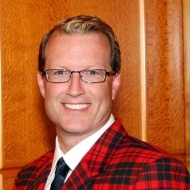Jeff Lawrence‘s twenty years in the design business has given him the opportunity to work alongside some of the greatest golf  course architects of our time: Gary Player, Jack Nicklaus, and Tom Fazio. Lawrence is currently working with Mr. Player on projects in Bulgaria; Abu Dhabi; Tenerife; Canada; and Costa Rica. Some of his other work includes Flint Hills National in Andover, Kansas; Stock Farm and Iron Horse in Montana; Members Club at Aldarra in Fall City, Washington; and Glenwild in Park City, Utah.
course architects of our time: Gary Player, Jack Nicklaus, and Tom Fazio. Lawrence is currently working with Mr. Player on projects in Bulgaria; Abu Dhabi; Tenerife; Canada; and Costa Rica. Some of his other work includes Flint Hills National in Andover, Kansas; Stock Farm and Iron Horse in Montana; Members Club at Aldarra in Fall City, Washington; and Glenwild in Park City, Utah.
It’s always a learning experience working with Gary Player, the most traveled man in the history of professional golf. Surprisingly, the most traveled man is a nervous flier!
Many times we’ll take private jets and helicopters. Mr. Player talks to the pilots to make sure the have enough hours. He’s always looking out the cockpit window and asking questions. We went through a thunderstorm in Florida once that had him very concerned.
I could not keep up with Mr. Player’s workout regimen, that’s for sure…and he’s over 70 years-old!
Mr. Player’s experience makes him the best when it comes to working with clients. He’s got a passion for what he does and is charismatic. Some architects are standoffish, but, considering his accomplishments in his lifetime, he can still sit down with anyone, carry on a conversation, and really care.
There are times when Mr. Player’s word goes a lot further than mine. When I get in a situation with the client, and the client needs some direction – particularly the ones in faraway lands who are new to golf – it’s good to have that little extra push from Mr. Player. He has a way of wording things, and just because of who he is and the way he says it, he educates people about a certain design feature and why it is in their best interest, even if it means increasing the budget.
Mr. Player is open-minded. We talk through things. There are certain design philosophies he is adamant about, though. Playability for the average golfer is important to Mr. Player, and despite being recognized as the greatest bunker player who ever lived, he doesn’t accept the long bunker shot as part of his design philosophy. Even though he is willing to debate most design strategies, he urges away from this design concept.
One of the most rewarding parts of my job is opening golf courses. Being able to play a game of golf on the course you personally designed gives you a feeling of pride unlike anything else. Opening courses also turns into a strategic report card: What do you like about the course? What could’ve been better? What changes should you make next time? You are able to critique your own performance.
Jack Nicklaus has very high standards for his work and is always trying to get things 100 percent correct. This is an excellent trait I learned from working for him.
When I was in college, I had the good fortune to caddy for Jack Nicklaus at the opening of the Desert Highlands course in Scottsdale, Arizona.
Early in the round, he asked for a yardage for his approach shot.
“What have we got here,” Nicklaus asked me.
“It looks like about one hundred forty-five or one hundred fifty yards,” I answered.
Nicklaus turned and looked at me as if I were from Mars.
“Well then, which is it?” he asked. “145 or 150?”
I then understood the kind of precision he expected.
“One hundred forty-seven, to be exact,” I said quickly!
